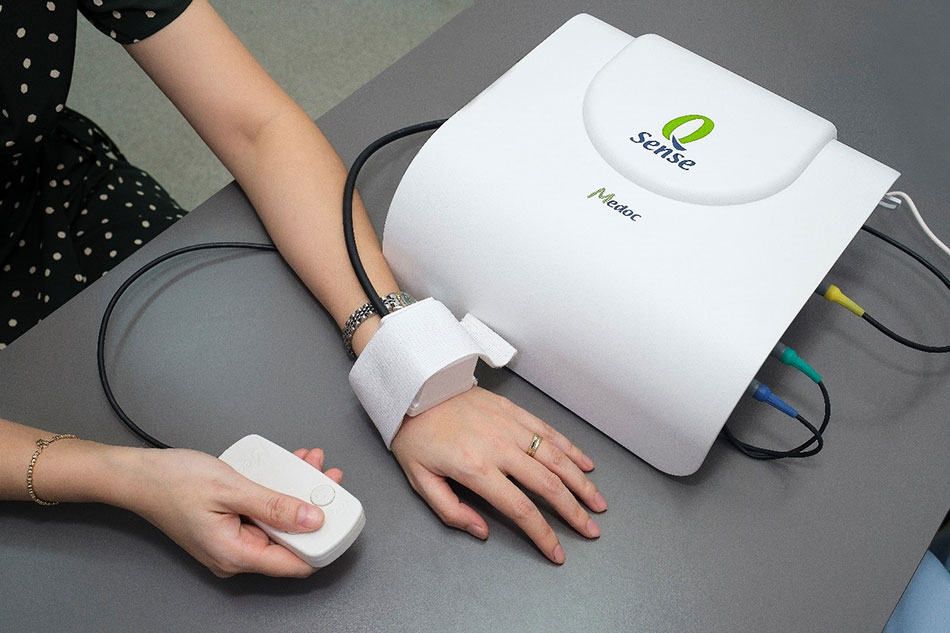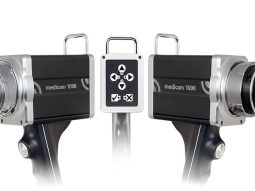The Pain Treatment Centre at FV Hospital is one of the first units in Vietnam to implement the Q-sense thermal threshold device, a new-generation Quantitative Sensory Testing (QST) tool for diagnosing pain caused by small fibre neuropathy. This is a significant advancement in the field of pain management, opening up more opportunities for accurate diagnosis and personalised pain treatment protocols for Vietnamese patients.
Challenges in diagnosing small fibre neuropathy using traditional QST methods
QST measures and assesses patients’ sensory perception to evaluate nerve function and classify nerve disorders. QST typically assists in the traditional clinical examination of chronic pain patients to identify abnormal sensations (increased or decreased pain perception) related to pain experiences or disabilities. Additionally, it serves as a tool to monitor patients’ treatment response over time.
Currently, most healthcare facilities utilise sensory testing methods through specialised equipment which can assess large nerve fibres (A-beta) and small nerve fibres (A-delta and C fibres). However, these methods rely heavily on subjective factors and to ensure more valuable and reliable testing, standardised assessment methods are needed.
In cases of pain related to small fibre neuropathy, clinical assessment is challenging, making it difficult for doctors to provide accurate diagnoses. More accurate diagnostic methods such as skin biopsy or nerve biopsy can be invasive, painful, and have limitations.

Ma Le Quan, MD, MSc, states that modern medicine has developed several advanced methods for diagnosing small fibre neuropathy.
According to Ma Le Quan, MD, MS, at the Internal Medicine Department, FV Hospital, when small fibre nerves are damaged (due to various underlying conditions such as diabetes, post-cancer chemotherapy, post-shingles, hepatitis C, or idiopathic causes), patients may experience pain and discomfort, including any of the following symptoms:
- Burning pain: an aching, burning, or stinging sensation in the affected areas of the skin. This pain is often described as spreading, uneven, and may occur suddenly.
- Sensitivity pain: Patients may become sensitive to light touch, temperature, and pressure. Even minor stimuli such as bright light, sunlight, or mild cold sensations can cause pain and discomfort.
- Needle-like pain: Some patients describe the sensation as needles or strong force piercing the skin, often accompanied by a tingling sensation, like wearing gloves or socks.
Pain resulting from small fibre neuropathy is a common condition, but each patient may experience different symptoms and varying levels of pain. In addition to pain symptoms, patients may also experience autonomic nervous system dysfunction (such as changes in skin colour, abnormal sweating, dry eyes and mouth, digestive disorders, and chest tightness).
Therefore, accurate diagnosis of this condition is crucial to improving treatment effectiveness and the quality of life for patients. However, it requires patience and meticulousness from doctors to accurately identify small nerve fibre injuries.
Q-sense: A modern QST device for accurate, non-invasive diagnosis of small fibre neuropathy
The Q-sense thermal threshold device is an important tool used in the diagnosis of small fibre neuropathy according to reputable international practice guidelines.
The device consists of a probe attached to the specific area being evaluated on the patient’s body. The probe can increase or decrease temperature, creating sensations of warmth and coldness as required during examination by the doctor.

Q-sense, a modern QST device for accurate, non-invasive diagnosis of small fibre neuropathy
The measured parameters are transferred to a computer for analysis by a programme which leverages a large amount of standardised data collected from major studies worldwide over many years. It also utilises standardised protocols that allow for comparing patients’ results with individuals of the same age/gender at each specific body location. This helps provide detailed information to assess nerve damage and changes in nerve function, aiding in diagnosis and selection of appropriate treatment methods.
Dr Nguyen Nam Binh, Specialist Level I, Pain Clinic, FV Hospital, states that the application of the advanced Q-sense device at FV Hospital will bring many benefits in the diagnosis and treatment of pain for patients. “Diagnosing pain caused by small fibre neuropathy based on clinical manifestations can be difficult and less accurate,” says Dr Binh.

Dr Nguyen Nam Binh, Specialist Level I, Pain Clinic, FV Hospital, conducts examinations and providing consultations to patients regarding small fibre neuropathy.
Q-sense gives doctors the ability to monitor the patient’s progress during the treatment process. By regularly measuring sensory parameters, small changes in nerve function can be detected early and the effectiveness of the therapy being implemented can be evaluated. This helps doctors to personalise optimal pain management protocols and tailor the treatment of other neuropathic conditions related to small fibre neuropathy for each patient.
The Pain Clinic is committed to developing advanced and scientific treatment methods, including using the Q-sense device in patient assessment. In addition, leveraging the multidisciplinary advantages of FV Hospital, the Clinic also receives prompt and accurate support from experts in related fields such as neurology, endocrinology, oncology, cardiology. This combination creates a comprehensive, multi-target treatment approach, ensuring that each patient receives the most effective treatment for a better quality of life.

 Vi
Vi 












